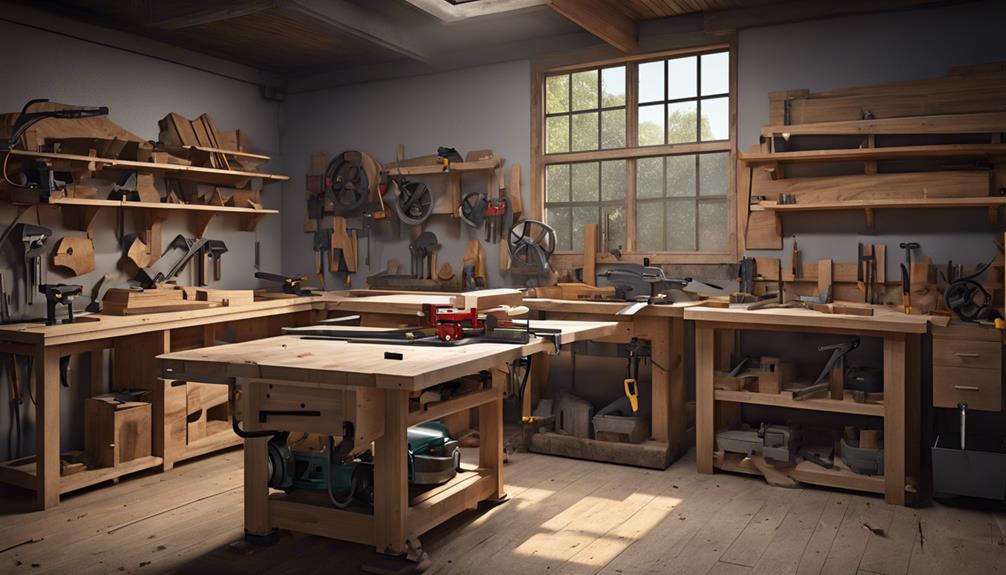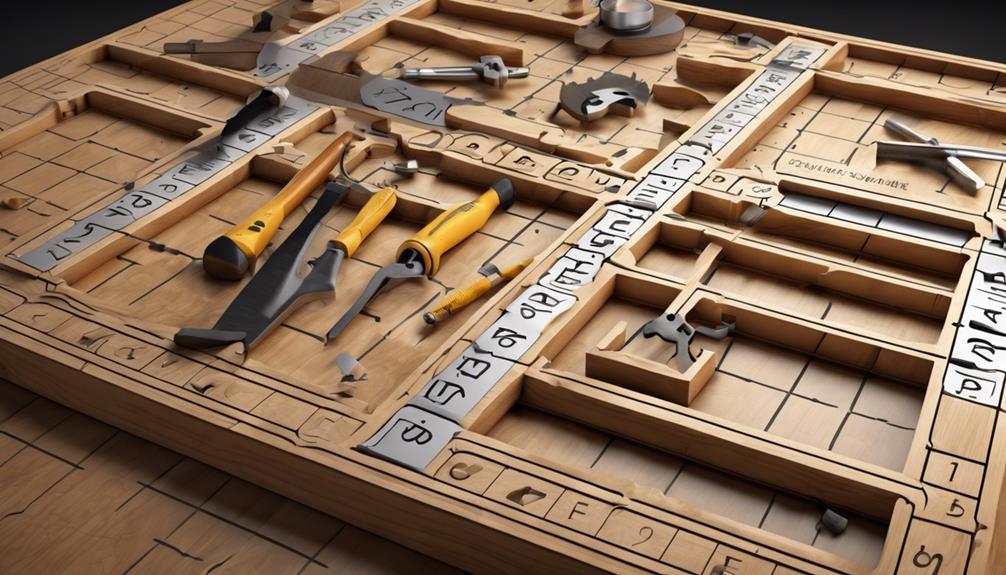Looking for a carpenter's tool crossword clue? One key term is 'chisel.' This sharp tool is essential for cutting and shaping wood with precision. Quickly carve out detailed designs with this essential hand tool. Want to uncover more woodworking tools hidden in the puzzle?
Key Takeaways
- Saw (e.g., circular, miter) for cutting
- Hammer for driving nails
- Chisel for shaping wood
- Level for ensuring straight surfaces
- Tape measure for accurate measurements
Types of Saws

When selecting saws for your carpentry projects, it's important to comprehend the various types available to make certain you have the right tool for the job. Circular saws are versatile tools that can handle a variety of cutting tasks, from straight cuts on lumber to beveled cuts for framing. They're a staple in any carpenter's toolkit due to their power and precision.
Reciprocating saws, on the other hand, are perfect for demolition work or cutting through tough materials like nails and piping. Their back-and-forth motion allows for efficient cutting in tight spaces.
Miter saws are essential for making precise angled cuts, commonly used for trim work, crown molding, or framing. With their ability to pivot and lock at different angles, they provide accuracy and repeatability in cutting wood to the desired length and angle.
Jigsaws are ideal for intricate cuts and curves, making them a go-to tool for projects that require detailed work like cutting out sink openings in countertops or creating unique shapes in wood pieces. Their thin blades and maneuverability allow for intricate designs that other saws may struggle with.
Understanding the strengths and purposes of circular saws, reciprocating saws, miter saws, and jigsaws will ensure that you can select the right tool for each specific task, leading to efficient and precise carpentry work.
Common Hand Tools
To excel in carpentry, a solid understanding of common hand tools is essential for executing precise and efficient woodworking projects. Proper tool organization and maintenance are key aspects of guaranteeing that your hand tools remain in top-notch condition for use. Here are some essential hand tools every carpenter should have in their arsenal:
| Category | Tools |
|---|---|
| Cutting Tools | Hand Saw |
| Coping Saw | |
| Chisel | |
| Measuring Tools | Tape Measure |
| Carpenter's Square | |
| Level | |
| Holding and Fastening | Hammer |
| Screwdrivers | |
| Clamps | |
| Shaping Tools | Block Plane |
| Surform Tool | |
| Rasps |
Proper organization of your tools ensures easy access and helps maintain a clutter-free workspace, enhancing efficiency during woodworking tasks. Regular maintenance, such as sharpening blades, oiling moving parts, and storing tools in a dry place, prolongs the lifespan of your hand tools and ensures they perform at their best. When it comes to measuring tools, accuracy is paramount in carpentry, making tools like tape measures, squares, and levels indispensable for achieving precision in your woodworking projects.
Power Tools

Understanding how to safely and effectively operate power tools is essential for carpenters looking to elevate their woodworking capabilities. When it comes to power tools, cordless drills and impact drivers are indispensable for woodworking projects.
Cordless drills offer freedom of movement without the constraint of a cord, making them versatile for various tasks such as drilling holes and driving screws. Impact drivers, on the other hand, provide high torque for driving screws efficiently, making them a valuable addition to your toolkit.
For woodworking projects, cordless drills are perfect for tasks like assembling furniture, installing cabinets, or building shelves. The key to using cordless drills effectively is to match the drill bit to the material and make sure the battery is fully charged before starting your project.
Impact drivers excel in driving long screws into tough materials like hardwood, making them ideal for tasks such as deck construction or framing.
Safety should always be a top priority when using power tools. Remember to wear appropriate safety gear such as goggles and ear protection. Before operating any power tool, familiarize yourself with its functions and read the user manual carefully.
Always maintain a firm grip on the tool and keep it away from your body and loose clothing to prevent accidents. By following these safety tips and mastering the use of cordless drills and impact drivers, you can enhance your woodworking skills and tackle projects with confidence.
Carpentry Materials
Selecting the right carpentry materials is vital for ensuring the quality and longevity of your woodworking projects. When engaging in woodworking techniques, it's essential to have the essential supplies on hand.
The choice of wood is paramount; hardwoods like oak, maple, and cherry are durable and suitable for building projects that require strength and a fine finish. Softwoods like pine and cedar are easier to work with and ideal for projects where weight is a concern.
In addition to the wood itself, having the right measuring tools is indispensable. A tape measure is a staple in any carpenter's toolkit, allowing you to take accurate measurements for precise cuts and fittings. A combination square is essential for ensuring that corners are square and angles are precise, contributing to the overall quality of your project.
When selecting materials for your carpentry projects, consider the specific requirements of the task at hand. Plywood is versatile and often used for structural components, while MDF (medium-density fiberboard) is excellent for projects that require a smooth, paintable finish.
Understanding the characteristics of different materials and how they align with your woodworking goals is key to achieving successful outcomes in your projects.
Tool-related Terminology

When discussing tool-related terminology in carpentry, it is important to familiarize yourself with the specific names and functions of various tools commonly used in woodworking projects. Understanding woodworking techniques, tool maintenance, tool safety, and wood joinery is essential for successful carpentry work. Below is a table highlighting some essential tool-related terms:
| Term | Definition |
|---|---|
| Bevel | An angled cut along the edge of a board. |
| Chisel | A sharp tool for cutting and shaping wood. |
| Dovetail Joint | A strong joint commonly used in woodworking for its durability. |
| Hand Plane | A tool used to smooth and shape wood surfaces. |
| Miter Saw | A saw used to make precise angled cuts in wood. |
| Rabbet | A groove cut into the edge of a piece of wood. |
Understanding these terms will not only help you communicate effectively with other carpenters but also make sure that you can follow instructions accurately when working on woodworking projects. Additionally, proper tool maintenance is vital to prolong the lifespan of your tools and maintain their effectiveness. Always prioritize tool safety to prevent accidents and injuries in the workshop. Finally, mastering wood joinery techniques like dovetail joints and using tools such as chisels and hand planes correctly will elevate the quality of your carpentry projects.
Conclusion
To sum up, when it comes to finding the right carpenter's tool, it's crucial to take into account the specific task at hand and choose the appropriate saw or hand tool.
Power tools can also be a valuable addition to your toolkit, making tasks quicker and more efficient.
Understanding the different types of saws, hand tools, and materials used in carpentry will help you tackle any project with confidence and precision.
Happy woodworking!
